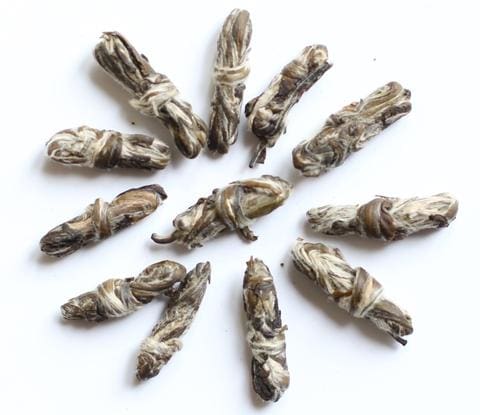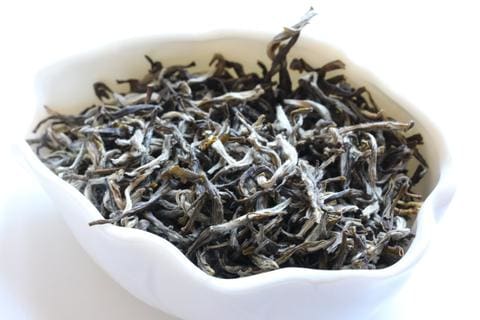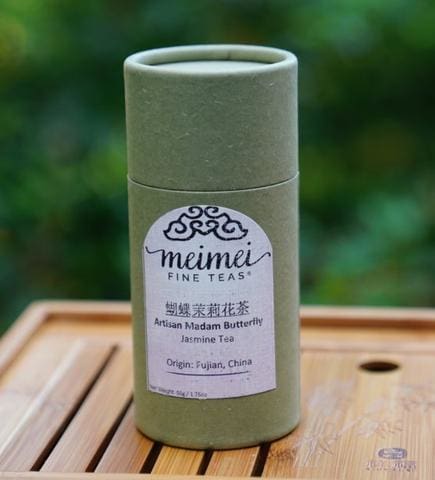
What Goes Into a Good Jasmine Tea?
It isn’t easy to find a good Jasmine tea.

As a tea buyer, we have to think about the base for the tea, the quality of the flowers, and the processing method used. It would probably be easiest to travel to a commercial district, secure a few pounds of the first one that we find, and go on our way. But what we gain in convenience, we lose in taste, aroma, and even health.
So what goes into a good Jasmine tea?
Believe it or not, tea flavoring has a long and storied tradition. Beginning during the Tang Dynasty (618 – 907 AD), artisans used to experiment with adding flavors to their pressed tea cakes, usually by rubbing a sweet paste on them or infusing them with botanical oils. It was during the Ming Dynasty (1368 – 1644 AD), however, that artisans invented methods to scent teas with the flowers themselves.
Through time, effort, and creativity, the Ming Dynasty artisans discovered three important variables that affected how well the tea leaves absorbed the aromas from scented flowers: (1) size of the leaf, (2) shape of the leaf, and (3) flavor of the leaf.
To control for both the size and flavor, tea leaves needed to be harvested at the right time of year. If it’s too early in the spring, you’ll end up with smaller leaves and more floral aromatics (smaller leaves have less surface area for scenting), but if you wait too long, the leaves will lose too much flavor. A good jasmine tea requires larger leaves that are still flavorful without competing with the taste of the jasmine.

For these reasons, we’ve found mid-April to make for an ideal plucking time.
But there is a problem. Jasmine flowers don’t blossom until later in the summer. This means that any tea plucked in the spring must be carefully stored until it is ready to be scented. If the tea isn’t stored properly or too much time passes, it degrades in quality, affecting the final taste in your cup.
You can imagine how costly this can be to produce. Not only must the tea be stored for a couple of months, if anything happens to it before it is ready for scenting, farmers stand to lose quite a bit of their investment. Though jasmine tea is highly demanded, you’ll have difficulty finding one that isn’t factory-produced.
In fact, some tea producers will ignore these important variables altogether. Not taking any risks, they’ll even scent their tea with jasmine essential oils or jasmine perfume. This results in a very low-quality form of jasmine tea, comparable to what you might find in a chain restaurant that doesn’t know how to source tea.
The problem is that once you have tasted just how good a traditional jasmine tea can be, it’s hard to settle for anything else, especially when you learn what can be in some of those perfumes. Thus, those of us who are interested in authentic jasmine tea will do everything we can to find one.
Taking all of this into consideration, one learns quickly that the best jasmine tea comes from Fuding in Fujian Province. Why Fuding?
Fuding is home to some cultivars that are perfect for scenting, most notably Bai Hao, which is the same cultivar used to produce the inimitable Silver Needles white tea. What makes Bai Hao work so well is that it has a very mellow flavor and a larger leaf that is conducive to rolling, as one might find in jasmine pearls or jasmine butterflies.

Fuding is also home to Jasminum sambac or Arabian Jasmine, renowned for its intoxicating fragrance. Because it is native to the area, this makes for ideal conditions to produce amazing jasmine tea using the traditional methods.
The jasmine teas that we have sourced at MeiMei Fine Teas are crafted using only the traditional methods, the same methods used during the Ming Dynasty, and our teas are scented with actual Arabian jasmine from Fuding using the Bai Hao cultivar, plucked in April. These choices have resulted in two exceptional jasmine teas that we know you’ll love: Premium Fuding Jasmine Tea and Butterfly Jasmine Tea.
If you’re new to jasmine tea, we recommend the Premium Fuding, but if you’re looking for the highest quality available, you can try the Butterfly Jasmine. The Butterfly requires larger, more pristine leaves than what you’ll find from pearls, and this shows in its flavor.
